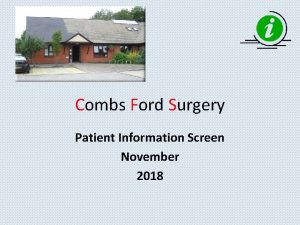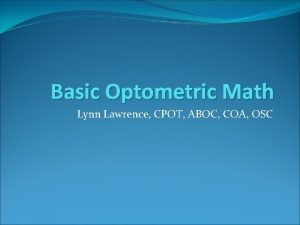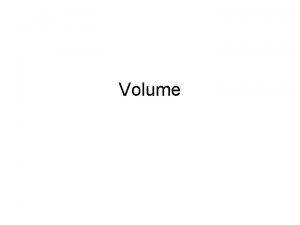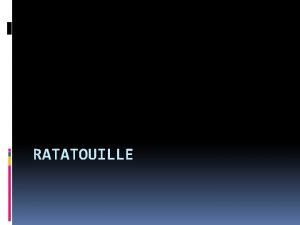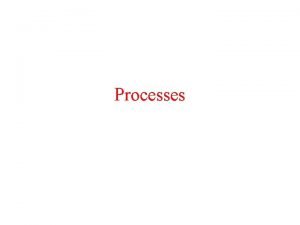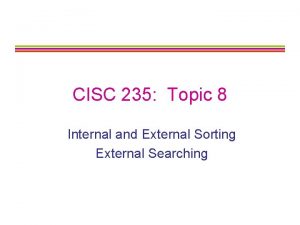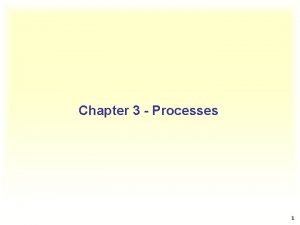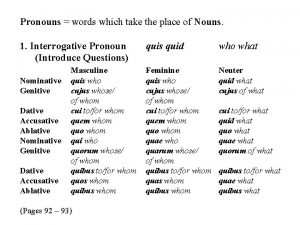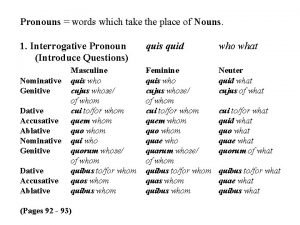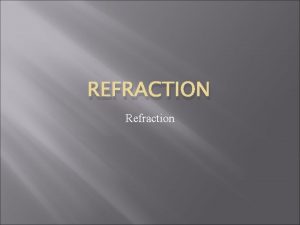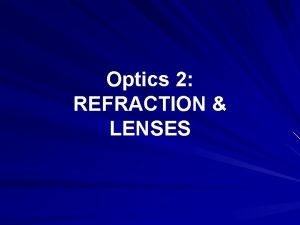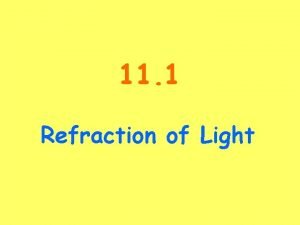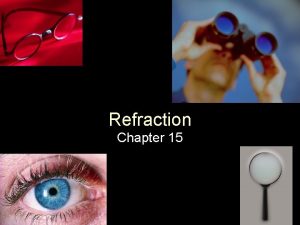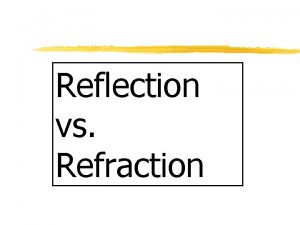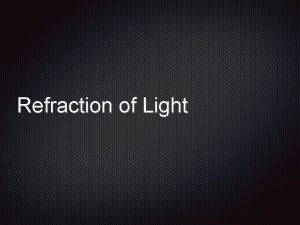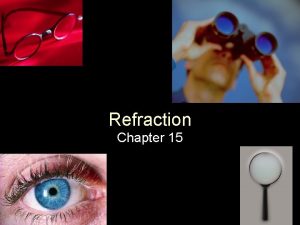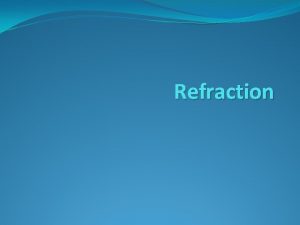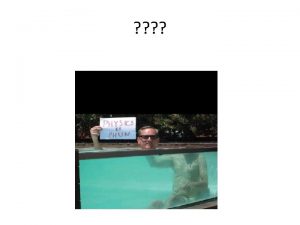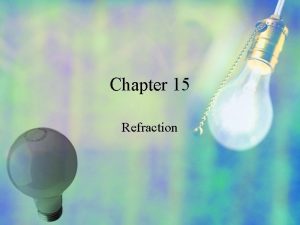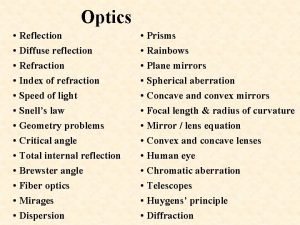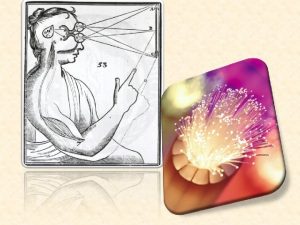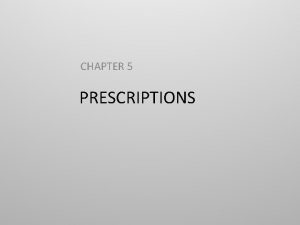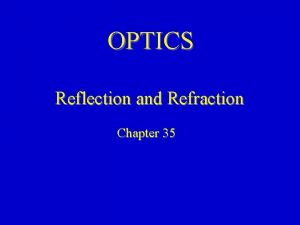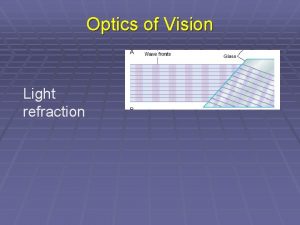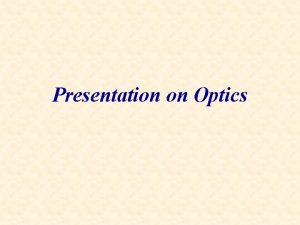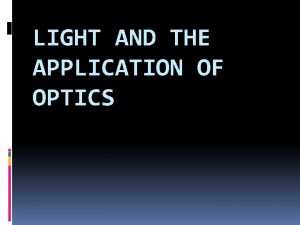OPTICS AND PRESCRIPTIONS How Much Refraction Takes Place

























- Slides: 25

OPTICS AND PRESCRIPTIONS

How Much Refraction Takes Place in the Normal Eye? • Normal eye generates approximately 60 diopters. • Each of the clear surfaces of the eye contribute at least some refraction.

Amount of Refraction Contributed by Each Structure Tears Conjunctiva Cornea Acqueous humor Lens Viterous humor 1 -2 diopters 3 -4 diopters 40 diopters 4 -5 diopters 5 -8 diopters 5 diopters

Conditions Which Cause Refractive Problems • Myopia (nearsightedness) • Hyperopia (farsightedness) • Astigmatism (everything’s blurry)

Can Refractive Errors be Corrected? Yes!!! Through the use of concave and convex lenses.

Correction of Refractive Errors • The myopic eye has too much refraction (bending power): • Ex: Normal = 60 and Myopic = 70 • The hyperopic eye has too little refraction: • Ex: Normal = 60 and Hyperopic = 50

History of Optical Correction • 1000 AD – reading stone that was laid on reading material to magnify it. • 1284 Italy -- Salvino D'Armate invented first pair of wearable glasses.

Eyeglasses from around 1400 • A reproduction of early wearable eyeglasses.

Early Representations in Art • The earliest representation of spectacles in artwork came from Tommaso da Modena. • Two brothers copying manuscripts – one with glasses, one with a magnifier.

Read More About It Go back to the Notes Index for our web site to go to a full article about the history of optics and prescriptions.

Types of Lenses • Single vision • Bifocal • Progressive • Reading glasses

Types of Lens Material • Glass • High index materials • Photochromic

Right Eye and Left Eye • OD = right eye • OS = left eye • OU = both eyes together

The Numbers and What They Mean – minus (-) • A minus (-) indicates taking away diopters of refraction. • People with a minus correction have myopia (nearsightedness). • The higher the number after the minus, the higher the degree of myopia.

Plus (+) • A plus (+) indicates adding diopters of refraction. • People with a plus correction have hyperopia (farsightedness). • The higher the number after the plus, the higher the degree of hyperopia.

Astigmatic correction (no. X no. ) • Two numbers separated by an X or the word “Axis” on a prescription indicates that the client has an astigmatism. • Remember that an astigmatism is some sort of “wave” in the shape of the cornea.

• The first number of the two will have a plus or (more typically) a minus in front of it. It represents the amount of refraction needed by the “wave. ” • The second number represents the direction (from 180 to 360 degrees) that the “wave” takes.

Add • Add means that a bifocal is needed and states the power that it will be. • Typically, these range from +0. 75 to +3. 00.

Prisms • If the basic prescription is followed by a small number with a superscript (1^) it indicates prism correction. • There may be more than one set of prism numbers for each eye.

Sample prescription

Sample prescription

Non-standard acuity notations • HM = hand motion • CF = count fingers at X feet • CSM = central steady and maintained • CSUM = central steady unmaintained • LP = Light perception • NLP = no light perception And my very favorite • Unable to test

WHEN GLASSES WON’T HELP. . .

That is your job- • That is when you are vital SO WHAT DO YOU DO • You Assess • You Plan – based on the data • You Intervene – implement you plan with all involved • Student • Parents/family • Teachers

And more • You modify and adapt the curriculum to give access • You assess again – How is your intervention going/working- is the student being successful – has you work made a positive impact • You inform • You train the student • To understand their abilites • To advocate for their needs • To raise their expections – challnege them! • You OBSERVE, LISTEN, AND LEARN
 Difference between ray optics and wave optics
Difference between ray optics and wave optics Venn diagram of geometric optics and physical optics
Venn diagram of geometric optics and physical optics Universal credit assessment period
Universal credit assessment period Combs ford surgery repeat prescriptions
Combs ford surgery repeat prescriptions How to transpose eye prescription
How to transpose eye prescription Story takes place
Story takes place The amount of space an object takes up
The amount of space an object takes up The characters struggle takes place
The characters struggle takes place Where does ratatouille take place
Where does ratatouille take place What raw materials does a plant need for photosynthesis
What raw materials does a plant need for photosynthesis Photosynthesis takes place in
Photosynthesis takes place in Random orientation of homologous chromosomes
Random orientation of homologous chromosomes How communication takes place
How communication takes place Internal sorting takes place in
Internal sorting takes place in Interest rate parity example
Interest rate parity example How communication takes place
How communication takes place External conflict literary definition
External conflict literary definition What is literary conflict
What is literary conflict Exploring lifespan development chapter 1
Exploring lifespan development chapter 1 Interprocessor communication takes place via
Interprocessor communication takes place via What is conflict
What is conflict Battling over clayoquot big trees
Battling over clayoquot big trees Indications for suspension therapy
Indications for suspension therapy Beowulf takes place in
Beowulf takes place in A word that takes the place of a noun
A word that takes the place of a noun Place pronouns
Place pronouns



